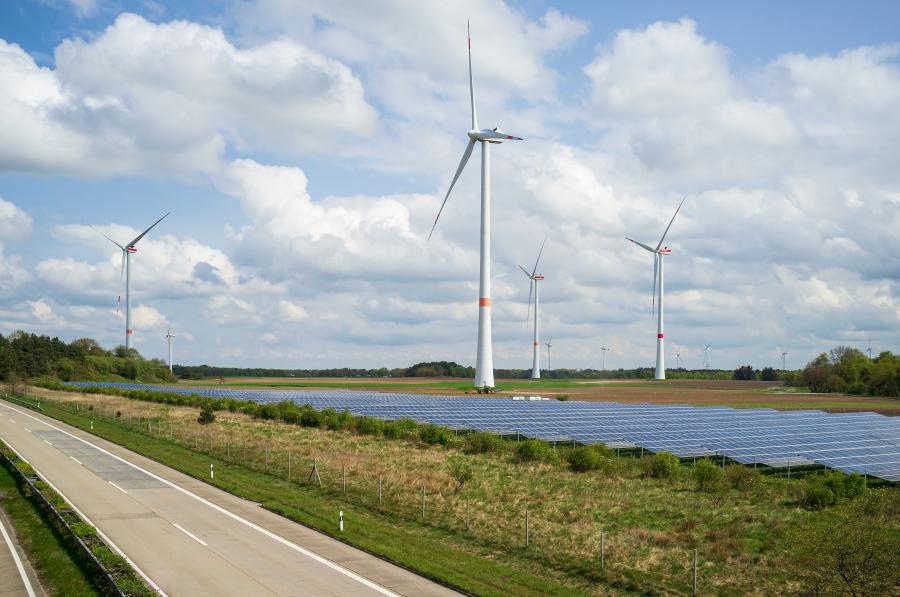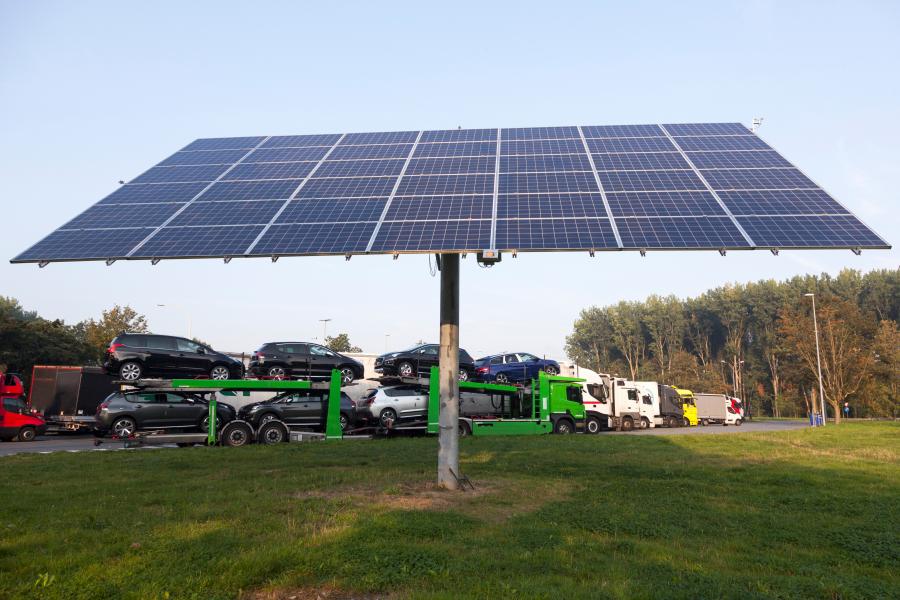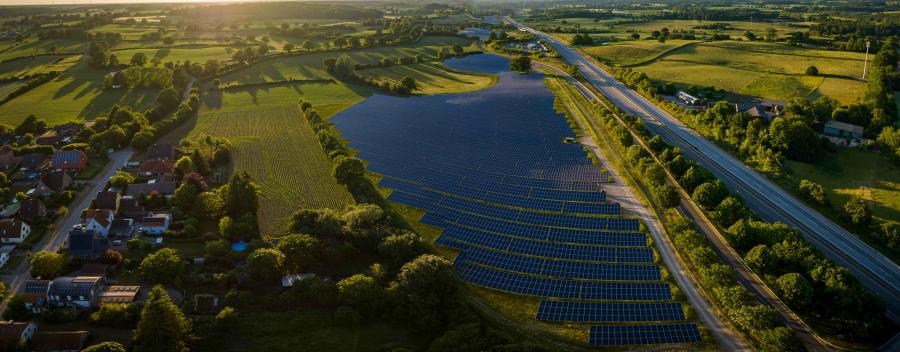More states are filling the neutral spaces in interstate medians and interchanges with solar panel arrays.
The dead space between stretches of interstate is coming alive across the country as states fill these neutral areas with solar panels. California is an early adopter of the concept, putting miles of otherwise empty expanses of land to good use. The Biden administration likes it as a straight path to reaching net-zero goals and is encouraging other states, such as Florida, Pennsylvania, Maryland and Maine, to join the bandwagon.
A recent study determined that power to more than 250,000 homes could be generated through solar grids at interchanges in just three counties.
The open space between busy traffic does not support wildlife, but in places like southern California it does get a lot of direct sunlight. In fact, Environment California and The Ray found that highway interchanges and off-ramps offer ideal installation sites.
Across the state, that adds up to "almost a gigawatt of potential solar power just from empty land," the two organizations found.
Tracking Positives
An article from electric vehicle news site electrek.co also cited the fact that these neutral spaces are often situated near transmission lines.
State ownership, noted electrek, makes these sites easier to develop than "contracting and leasing for land, building transmission lines and so on."
Clean energy advocates Steven King and David Peters say there are other benefits to installing solar grids on highway neutral sites. Locating at these spots contributes to a clean energy future, said King, of Environment California and Peters with The Ray. They can mitigate the effects of extreme heat on the electric grid in place, the two told advocacy federation Environment America.
Paired with battery storage systems, they said, these fields "can continue providing clean energy to the electric grid even after the sun sets."
The technology also can save money and generate revenue at the state level, said King and Peters. It "presents an opportunity for California to generate revenue while saving money by reducing ongoing roadside maintenance expenses."
When solar developers maintain their sites along highways, maintenance costs drop for the state. Finally, utilizing these areas to develop solar power leverages existing highways to full productivity, said the two advocates.
FHWA noted in 2021 guidance that these projects also reduce pollution and greenhouse gasses, promote energy security and foster green jobs.
Additionally, the Biden administration considers repurposing rights-of-way for energy infrastructure to be a "net-zero game changer" that can help the country meet its climate goals.
Leading the Charge
In 2021, FHWA suggested states adopt legislation in favor of utilizing land along the interstates in this way.
The Ray mapped such opportunities on a national level and noted several states, including Georgia, Oregon, Maine, Pennsylvania and Maryland have seen the light. And the sites don't require massive spans of acreage to shine. In west Georgia, a 4-acre stretch on the shoulder of I-85 has been transformed.
Currently generating energy through 2,600 solar panels, the site was established by The Ray working with state organizations.
Allie Kelly, executive director, told the Columbus, Ga., Ledger-Enquirer that The Ray seeks to combine transportation land and energy needs. The idea is to create clean energy from utilization of the green turf along highways.
"Georgia alone has 19,000 suitable acres for right-of-way solar installation," Kelly told the Ledger-Enquirer. "This is empty land that the public owns. Using that land for solar is simple and elegant."
Though the campaign in Georgia is not the only one of its kind, the fact that it's a collaboration among multiple agencies makes it unique. The state entities came together with The Ray to develop a one-megawatt project featuring native plants and pollinator gardens. The site also encourages bees to perform their pollinating magic under cover of the solar panels.
Kelly said the project had its challenges: "It was like crawling over broken glass to get [the project] done at times."
In fact, it "nearly died and had to be resuscitated, because the Federal Highway Administration did not have a unified vision" back then, she said.
"Our pain developed a national plan for the FHWA to create consistency and conformity of how it would treat these projects."
The Georgia project became a model for the FHWA to set a consistent national program to encourage and support these types of projects, said Kelly.
Tina Hodges, an FHWA environmental protection specialist, and Amy Plovnick, a USDOT community planner, foresee technological advances. The two tracked solar highway infrastructure programs across the country and highlighted advanced DOT programs for an article in Public Roads magazine.
They found that once Maine DOT got on board, the result was three solar projects in Augusta, Maine, developed with Central Main Power. The three will generate eight megawatts of energy, enough to power 1,850 homes and reduce state electricity costs by $5.5 million over the next 20 years.
They should reduce greenhouse gas emissions by 8 million lbs. annually, the equivalent of 8,393 barrels of oil. Instead of shelling out funds to mow green turf, the Maine DOT receives $56,000 a year from the solar developer, Synergy, who leases the property.
In 2007, Oregon directed state agencies to meet 100 percent of their electrical needs in renewable energy by 2025. That pushed the state DOT to implement the first large-scale solar roadway projects in the country as demonstration projects, noted Hodges and Plovnick.
By the next year, the state completed a 104-kilowatt, 594-panel project at the interchange of I-5 and I-25 outside of Portland, Ore. Because of a successful deal with Portland General Electric on that site, four years later the partners installed a large-sale project at a rest area along I-5. A 1.75-megawatt project, it features nearly 7,000 solar panels on a 7-acre state-owned site. The solar field produces about 2 million kilowatt-hours of renewable energy each year.
Massachusetts DOT researched the potential of ROW solar in 2012, identifying and vetting approximately 60 potential sites in the process. A contract was awarded two years later for a 6-megawatt solar ROW project across multiple locations.
The majority of Massachusetts ROW sites are along the state turnpike, I-90. One site is located on Route 3 in Plymouth.
"MassDOT's solar projects were public-private partnerships and required no upfront funding from the state," said Hodges and Plovnick.
The state leased the sites to the developer for 20 years and agreed to purchase all the energy generated through power purchase agreements (PPA).
"MassDOT also benefits from a net metering policy in which the agency receives credits on identified utility accounts," the two said. "The developer benefits from the guaranteed sale of electricity to MassDOT and through state renewable energy credits and federal tax incentives."
As of August 2018, the eight sites combined produced 10,750 megawatt-hours of electricity, saving MassDOT more than $1 million. The state agency expects to save approximately $525,000 annually, in addition to $75,000 coming in from annual lease payments.
Maryland DOT began installation of solar power at 35 MDOT sites including buildings and parking lots. The state agency licensed land to the developer who constructed, owns, operates and maintains the renewable energy infrastructure.
"MDOT will buy power at a fixed rate for 20 to 25 years, and expects electricity cost savings of 30 to 40 percent," said Hodge and Plovnick.
In addition, the program is expected to generate 298 construction and 28 operations and maintenance jobs, with more positions added as solar expands.
"This project allows MDOT to save money, support jobs and create a renewable energy source," said Pete K. Rahn, then Maryland transportation secretary.
The 35 sites generate 46,000 megawatt-hours per year, or approximately 12 percent of the state's annual electricity usage. The energy will be used at MDOT facilities or by neighboring residents or businesses that are part of Maryland's Community Solar Pilot Program.
Full Federal Support
This past spring, the fed added $2.5 billion to the $5 billion in place to support installation of electric chargers every 50 miles of interstate.
Kelly sees forward movement: "The transportation sector is now intertwined with the energy sector," she said.
FHWA fully supports highway renewable energy. Through resource development and workshop funding, the agency encourages information sharing.
Early right-of-way solar users and those exploring renewables provide lessons based on their experiences for those considering future options.
"By sharing their challenges and successes with their peers, state DOTs are learning from each other," said FHWA.
Most state renewable energy projects are ground-mounted panels along the right-of-way (ROW) and on the roofs of carports and buildings at rest areas. Some small wind turbines can be spotted at rest areas. FHWA foresees solar roadway surfaces, photovoltaic noise barriers and under-bridge turbines.
"As technologies advance, opportunities may arise to incorporate additional types of renewable energy beyond pilot projects," Hodges and Plovnick said.
Examples include solar roadway surfaces, photovoltaic noise barriers, tidal turbines under bridges or micro-wind turbines.
"We're thrilled to see DOTs generating clean, renewable energy on their properties where feasible," said Michael Culp, FHWA sustainability team leader. "This gives us an opportunity to help them save money and also protect the natural environment."
In fact, FHWA offers resources designed to aid state DOTs in developing renewable energy projects, including solar power infrastructure. As interest in right-of-way renewable energy grows at the state level and available technologies expand, the agency plans to be visible and accessible to DOTs. CEG
Today's top stories























